Health Intervention Proposal: Walking, Yoga for Office Workers
VerifiedAdded on 2023/03/20
|24
|6066
|28
Report
AI Summary
This report details a health intervention proposal designed to address the issue of sedentary lifestyles among office workers. The introduction highlights the detrimental health effects of prolonged sitting, including increased risks of various diseases and premature death, supported by statistics from the World Health Organization and the British Heart Foundation. The rationale emphasizes the metabolic consequences of inactivity and the benefits of mild to moderate physical activity like walking and yoga. The proposal utilizes the Behavior Change Wheel (BCW) model to develop a health intervention, outlining the key components such as target behavior specification, behavior diagnosis, and strategy selection. The aims and objectives are to identify and mitigate factors influencing physical activity, and evaluate the effectiveness of yoga and walking classes in reducing negative health outcomes. Research questions focus on identifying influencers and barriers, regulating these factors, and assessing the effectiveness of the intervention strategies. The methodology, based on the BCW model, includes a focus group interview for behavior diagnosis, intervention strategies like educational programs, and environmental restructuring, and an evaluation strategy to assess outcomes. The report also addresses ethical and legal considerations and discusses potential implementation issues. The proposal suggests that implementing walking and yoga classes will reduce sitting times and improve health outcomes. The report concludes with references to relevant literature.
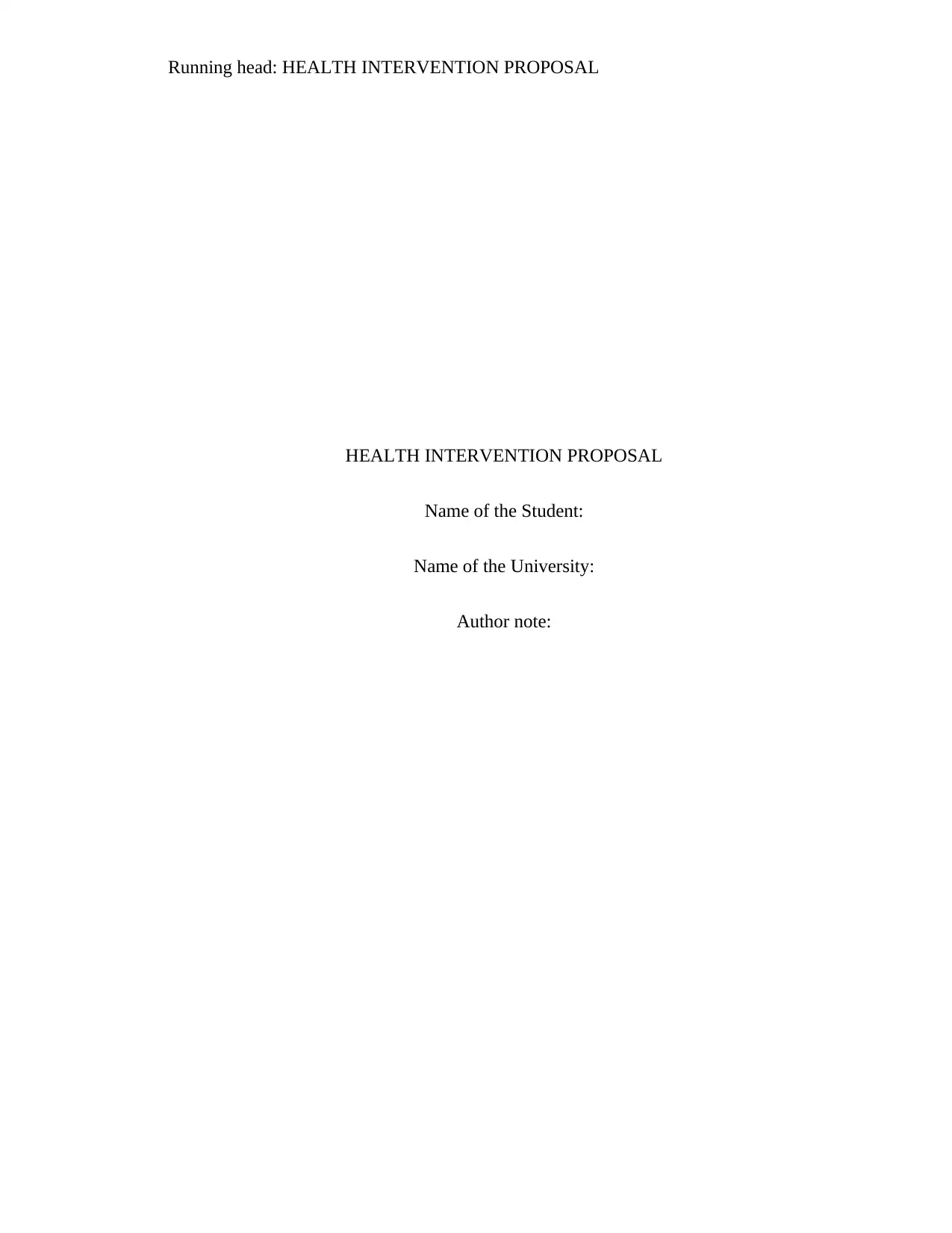
Running head: HEALTH INTERVENTION PROPOSAL
HEALTH INTERVENTION PROPOSAL
Name of the Student:
Name of the University:
Author note:
HEALTH INTERVENTION PROPOSAL
Name of the Student:
Name of the University:
Author note:
Paraphrase This Document
Need a fresh take? Get an instant paraphrase of this document with our AI Paraphraser

1HEALTH INTERVENTION PROPOSAL
Table of Contents
1. Introduction......................................................................................................................2
1.1. Background...............................................................................................................2
1.2. Rationale...................................................................................................................3
1.3. Aims and Objectives.................................................................................................7
1.4. Research Questions and Hypothesis.........................................................................7
2. Method.............................................................................................................................8
2.1. The Behavior Change Wheel (BCW) Model............................................................8
2.2. Design.......................................................................................................................9
2.3. Participants.............................................................................................................11
2.4. Sample Selection....................................................................................................11
2.5. Strategies and Procedures.......................................................................................11
2.6. Size.........................................................................................................................12
2.7. Materials.................................................................................................................12
2.8. Relevant Psychological Theory..............................................................................13
2.9. Ethical and Legal Issues.........................................................................................14
2.10. Funding.................................................................................................................14
3. Evaluation......................................................................................................................14
3.1. Data Analysis Strategy...........................................................................................14
3.2. Outcome Evaluation...............................................................................................14
Table of Contents
1. Introduction......................................................................................................................2
1.1. Background...............................................................................................................2
1.2. Rationale...................................................................................................................3
1.3. Aims and Objectives.................................................................................................7
1.4. Research Questions and Hypothesis.........................................................................7
2. Method.............................................................................................................................8
2.1. The Behavior Change Wheel (BCW) Model............................................................8
2.2. Design.......................................................................................................................9
2.3. Participants.............................................................................................................11
2.4. Sample Selection....................................................................................................11
2.5. Strategies and Procedures.......................................................................................11
2.6. Size.........................................................................................................................12
2.7. Materials.................................................................................................................12
2.8. Relevant Psychological Theory..............................................................................13
2.9. Ethical and Legal Issues.........................................................................................14
2.10. Funding.................................................................................................................14
3. Evaluation......................................................................................................................14
3.1. Data Analysis Strategy...........................................................................................14
3.2. Outcome Evaluation...............................................................................................14
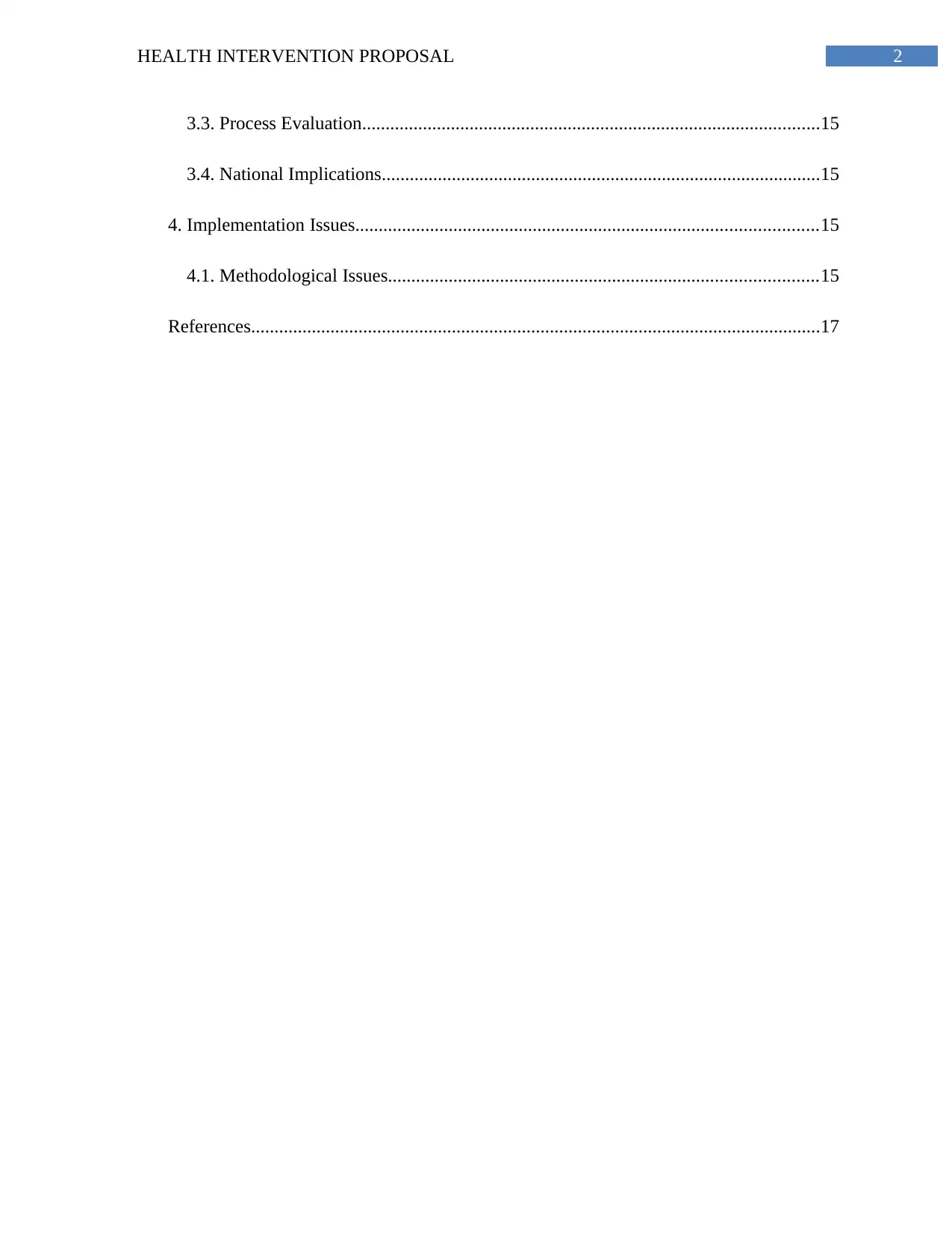
2HEALTH INTERVENTION PROPOSAL
3.3. Process Evaluation..................................................................................................15
3.4. National Implications..............................................................................................15
4. Implementation Issues...................................................................................................15
4.1. Methodological Issues............................................................................................15
References..........................................................................................................................17
3.3. Process Evaluation..................................................................................................15
3.4. National Implications..............................................................................................15
4. Implementation Issues...................................................................................................15
4.1. Methodological Issues............................................................................................15
References..........................................................................................................................17
⊘ This is a preview!⊘
Do you want full access?
Subscribe today to unlock all pages.

Trusted by 1+ million students worldwide
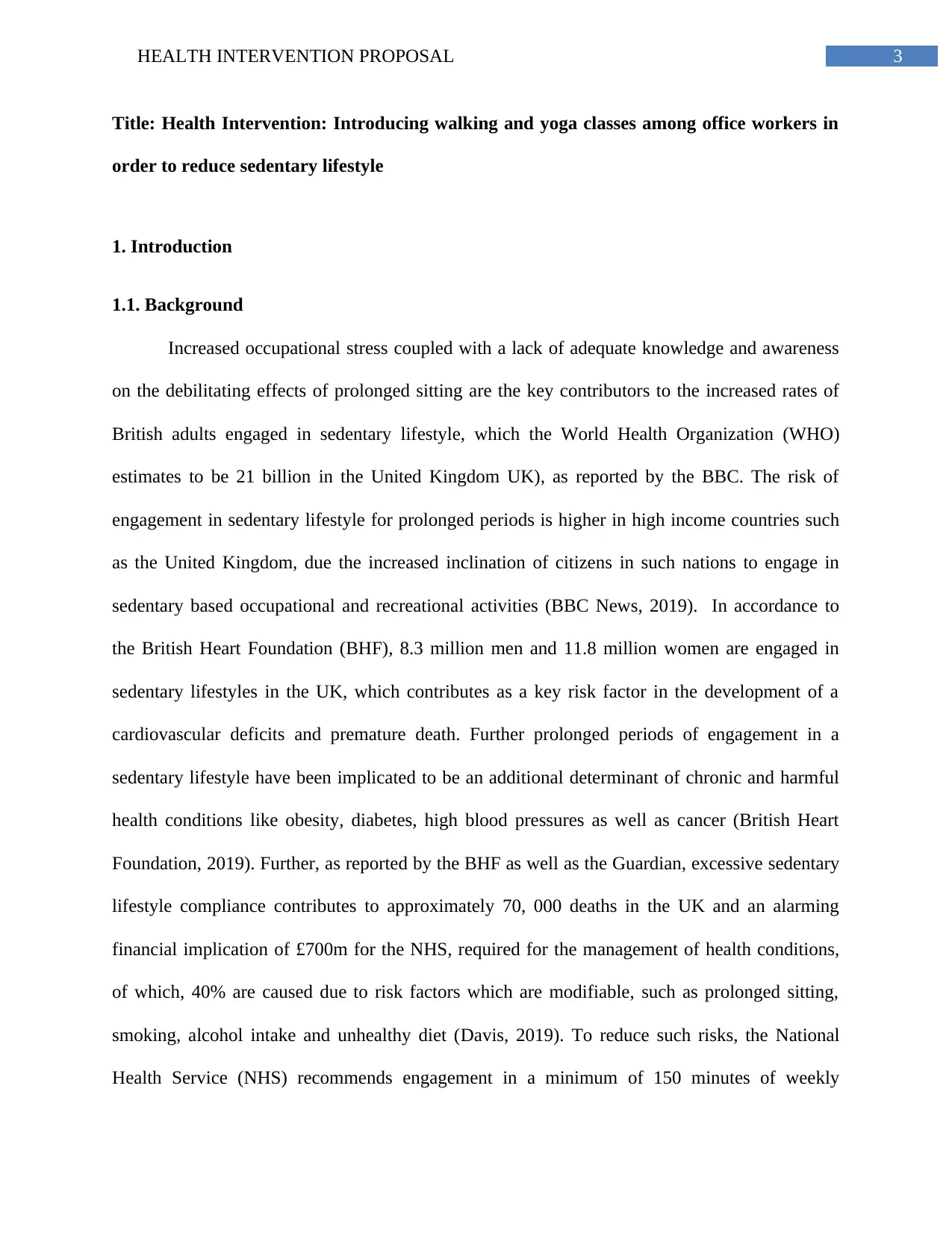
3HEALTH INTERVENTION PROPOSAL
Title: Health Intervention: Introducing walking and yoga classes among office workers in
order to reduce sedentary lifestyle
1. Introduction
1.1. Background
Increased occupational stress coupled with a lack of adequate knowledge and awareness
on the debilitating effects of prolonged sitting are the key contributors to the increased rates of
British adults engaged in sedentary lifestyle, which the World Health Organization (WHO)
estimates to be 21 billion in the United Kingdom UK), as reported by the BBC. The risk of
engagement in sedentary lifestyle for prolonged periods is higher in high income countries such
as the United Kingdom, due the increased inclination of citizens in such nations to engage in
sedentary based occupational and recreational activities (BBC News, 2019). In accordance to
the British Heart Foundation (BHF), 8.3 million men and 11.8 million women are engaged in
sedentary lifestyles in the UK, which contributes as a key risk factor in the development of a
cardiovascular deficits and premature death. Further prolonged periods of engagement in a
sedentary lifestyle have been implicated to be an additional determinant of chronic and harmful
health conditions like obesity, diabetes, high blood pressures as well as cancer (British Heart
Foundation, 2019). Further, as reported by the BHF as well as the Guardian, excessive sedentary
lifestyle compliance contributes to approximately 70, 000 deaths in the UK and an alarming
financial implication of £700m for the NHS, required for the management of health conditions,
of which, 40% are caused due to risk factors which are modifiable, such as prolonged sitting,
smoking, alcohol intake and unhealthy diet (Davis, 2019). To reduce such risks, the National
Health Service (NHS) recommends engagement in a minimum of 150 minutes of weekly
Title: Health Intervention: Introducing walking and yoga classes among office workers in
order to reduce sedentary lifestyle
1. Introduction
1.1. Background
Increased occupational stress coupled with a lack of adequate knowledge and awareness
on the debilitating effects of prolonged sitting are the key contributors to the increased rates of
British adults engaged in sedentary lifestyle, which the World Health Organization (WHO)
estimates to be 21 billion in the United Kingdom UK), as reported by the BBC. The risk of
engagement in sedentary lifestyle for prolonged periods is higher in high income countries such
as the United Kingdom, due the increased inclination of citizens in such nations to engage in
sedentary based occupational and recreational activities (BBC News, 2019). In accordance to
the British Heart Foundation (BHF), 8.3 million men and 11.8 million women are engaged in
sedentary lifestyles in the UK, which contributes as a key risk factor in the development of a
cardiovascular deficits and premature death. Further prolonged periods of engagement in a
sedentary lifestyle have been implicated to be an additional determinant of chronic and harmful
health conditions like obesity, diabetes, high blood pressures as well as cancer (British Heart
Foundation, 2019). Further, as reported by the BHF as well as the Guardian, excessive sedentary
lifestyle compliance contributes to approximately 70, 000 deaths in the UK and an alarming
financial implication of £700m for the NHS, required for the management of health conditions,
of which, 40% are caused due to risk factors which are modifiable, such as prolonged sitting,
smoking, alcohol intake and unhealthy diet (Davis, 2019). To reduce such risks, the National
Health Service (NHS) recommends engagement in a minimum of 150 minutes of weekly
Paraphrase This Document
Need a fresh take? Get an instant paraphrase of this document with our AI Paraphraser

4HEALTH INTERVENTION PROPOSAL
physical activity (National Health Service, 2019). However, as per the BHF’s Physical Inactivity
and Sedentary Behavior Report 2017, 60% of adults in the UK lack awareness on these
guidelines and the harmful effects of sedentary lifestyle and prolonged sitting. Hence, the need of
the hour is to implement a health behavior change process which will be effective in targeting the
perceived barriers underlying this unawareness among adults, as well as modify adherence to
sedentary activities at the workplace (British Heart Foundation, 2019).
1.2. Rationale
Prolonged engagement in sitting results in reduction in the metabolic effectiveness of an
individual, leading to slowing down of metabolism and reduced capabilities of the individual’s
body to metabolize dietary fat, sugar and additional nutrients hence contributing to high blood
pressure and glucose and disruption in the lipid profiles (Bailey & Locke, 2015). Lack of
mitigation of workers engagement to such sedentary occupational environments further results in
aggravation of symptoms to yield chronic metabolic conditions such as diabetes, hypertension,
dyslipidemia, cancer and fatal consequences such as untimely death. The symptoms of such
disease conditions have been implicated to be modifiable and reversible with health interventions
aimed at reduction of sitting and increased compliance to mild and moderate levels of physical
activity as recommended by the NHS (Mainous et al., 2019). Hence, one of the key rationales
underlying the administration of a physical activity based health intervention plan is the
prevention of fatal and chronic metabolic harmful lifestyle health conditions.
Mild to moderate physical activities such as walking and yoga have been implicated to
yield beneficial effects by reversing the metabolic complications associated with sitting and
sedentary lifestyle (Rockette-Wagner et al., 2015). Authors Balaji and Varne (2017), examined
physical activity (National Health Service, 2019). However, as per the BHF’s Physical Inactivity
and Sedentary Behavior Report 2017, 60% of adults in the UK lack awareness on these
guidelines and the harmful effects of sedentary lifestyle and prolonged sitting. Hence, the need of
the hour is to implement a health behavior change process which will be effective in targeting the
perceived barriers underlying this unawareness among adults, as well as modify adherence to
sedentary activities at the workplace (British Heart Foundation, 2019).
1.2. Rationale
Prolonged engagement in sitting results in reduction in the metabolic effectiveness of an
individual, leading to slowing down of metabolism and reduced capabilities of the individual’s
body to metabolize dietary fat, sugar and additional nutrients hence contributing to high blood
pressure and glucose and disruption in the lipid profiles (Bailey & Locke, 2015). Lack of
mitigation of workers engagement to such sedentary occupational environments further results in
aggravation of symptoms to yield chronic metabolic conditions such as diabetes, hypertension,
dyslipidemia, cancer and fatal consequences such as untimely death. The symptoms of such
disease conditions have been implicated to be modifiable and reversible with health interventions
aimed at reduction of sitting and increased compliance to mild and moderate levels of physical
activity as recommended by the NHS (Mainous et al., 2019). Hence, one of the key rationales
underlying the administration of a physical activity based health intervention plan is the
prevention of fatal and chronic metabolic harmful lifestyle health conditions.
Mild to moderate physical activities such as walking and yoga have been implicated to
yield beneficial effects by reversing the metabolic complications associated with sitting and
sedentary lifestyle (Rockette-Wagner et al., 2015). Authors Balaji and Varne (2017), examined
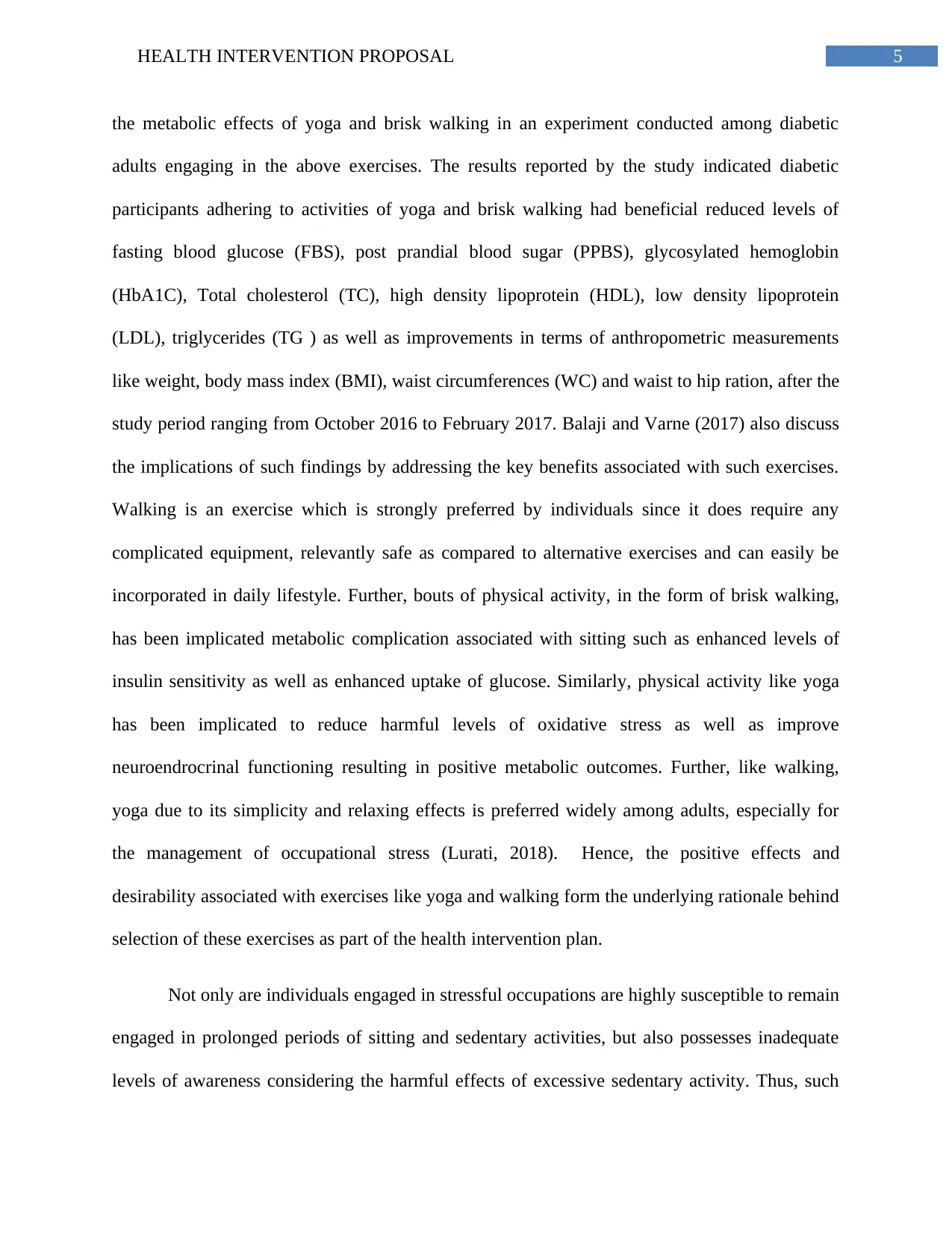
5HEALTH INTERVENTION PROPOSAL
the metabolic effects of yoga and brisk walking in an experiment conducted among diabetic
adults engaging in the above exercises. The results reported by the study indicated diabetic
participants adhering to activities of yoga and brisk walking had beneficial reduced levels of
fasting blood glucose (FBS), post prandial blood sugar (PPBS), glycosylated hemoglobin
(HbA1C), Total cholesterol (TC), high density lipoprotein (HDL), low density lipoprotein
(LDL), triglycerides (TG ) as well as improvements in terms of anthropometric measurements
like weight, body mass index (BMI), waist circumferences (WC) and waist to hip ration, after the
study period ranging from October 2016 to February 2017. Balaji and Varne (2017) also discuss
the implications of such findings by addressing the key benefits associated with such exercises.
Walking is an exercise which is strongly preferred by individuals since it does require any
complicated equipment, relevantly safe as compared to alternative exercises and can easily be
incorporated in daily lifestyle. Further, bouts of physical activity, in the form of brisk walking,
has been implicated metabolic complication associated with sitting such as enhanced levels of
insulin sensitivity as well as enhanced uptake of glucose. Similarly, physical activity like yoga
has been implicated to reduce harmful levels of oxidative stress as well as improve
neuroendrocrinal functioning resulting in positive metabolic outcomes. Further, like walking,
yoga due to its simplicity and relaxing effects is preferred widely among adults, especially for
the management of occupational stress (Lurati, 2018). Hence, the positive effects and
desirability associated with exercises like yoga and walking form the underlying rationale behind
selection of these exercises as part of the health intervention plan.
Not only are individuals engaged in stressful occupations are highly susceptible to remain
engaged in prolonged periods of sitting and sedentary activities, but also possesses inadequate
levels of awareness considering the harmful effects of excessive sedentary activity. Thus, such
the metabolic effects of yoga and brisk walking in an experiment conducted among diabetic
adults engaging in the above exercises. The results reported by the study indicated diabetic
participants adhering to activities of yoga and brisk walking had beneficial reduced levels of
fasting blood glucose (FBS), post prandial blood sugar (PPBS), glycosylated hemoglobin
(HbA1C), Total cholesterol (TC), high density lipoprotein (HDL), low density lipoprotein
(LDL), triglycerides (TG ) as well as improvements in terms of anthropometric measurements
like weight, body mass index (BMI), waist circumferences (WC) and waist to hip ration, after the
study period ranging from October 2016 to February 2017. Balaji and Varne (2017) also discuss
the implications of such findings by addressing the key benefits associated with such exercises.
Walking is an exercise which is strongly preferred by individuals since it does require any
complicated equipment, relevantly safe as compared to alternative exercises and can easily be
incorporated in daily lifestyle. Further, bouts of physical activity, in the form of brisk walking,
has been implicated metabolic complication associated with sitting such as enhanced levels of
insulin sensitivity as well as enhanced uptake of glucose. Similarly, physical activity like yoga
has been implicated to reduce harmful levels of oxidative stress as well as improve
neuroendrocrinal functioning resulting in positive metabolic outcomes. Further, like walking,
yoga due to its simplicity and relaxing effects is preferred widely among adults, especially for
the management of occupational stress (Lurati, 2018). Hence, the positive effects and
desirability associated with exercises like yoga and walking form the underlying rationale behind
selection of these exercises as part of the health intervention plan.
Not only are individuals engaged in stressful occupations are highly susceptible to remain
engaged in prolonged periods of sitting and sedentary activities, but also possesses inadequate
levels of awareness considering the harmful effects of excessive sedentary activity. Thus, such
⊘ This is a preview!⊘
Do you want full access?
Subscribe today to unlock all pages.

Trusted by 1+ million students worldwide
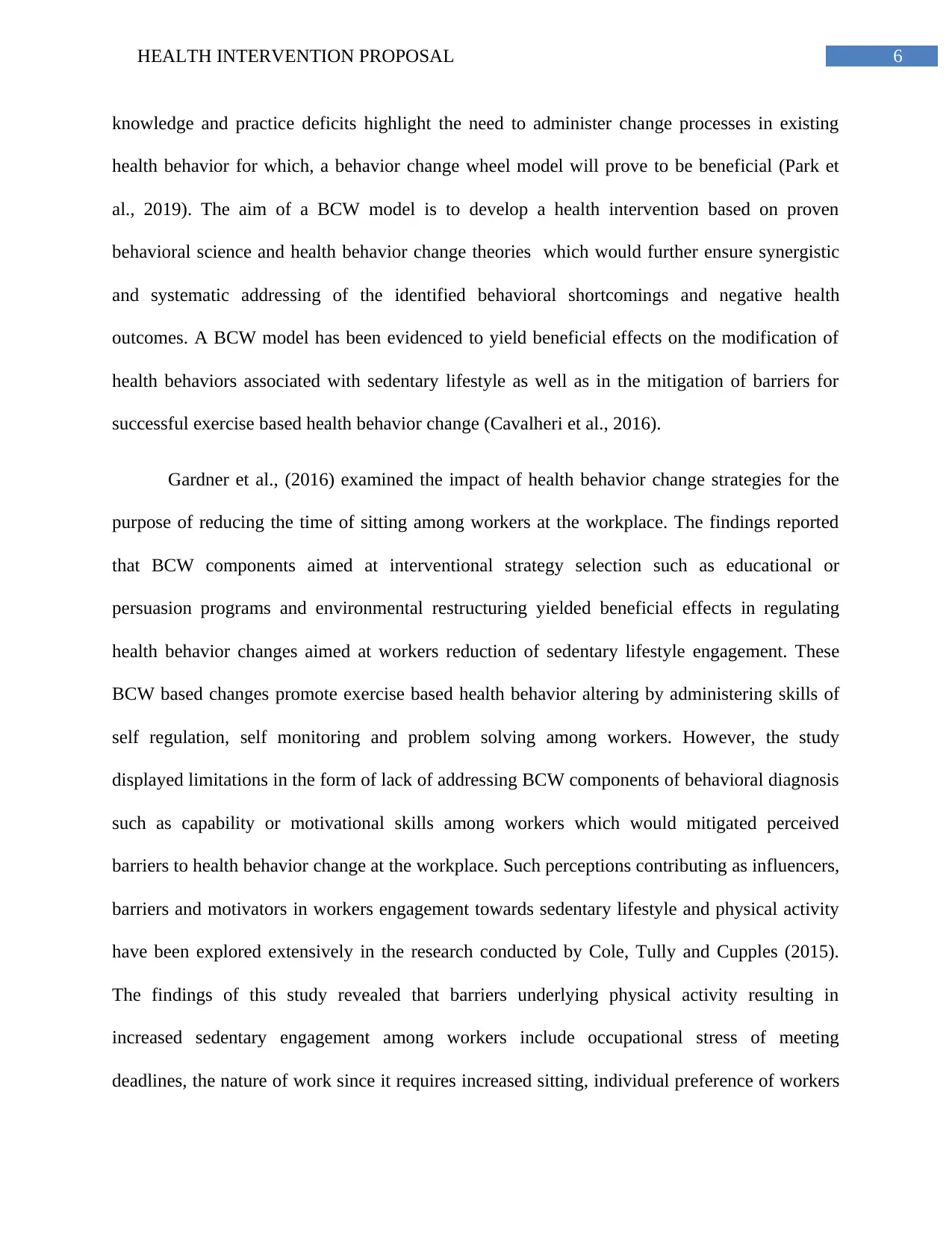
6HEALTH INTERVENTION PROPOSAL
knowledge and practice deficits highlight the need to administer change processes in existing
health behavior for which, a behavior change wheel model will prove to be beneficial (Park et
al., 2019). The aim of a BCW model is to develop a health intervention based on proven
behavioral science and health behavior change theories which would further ensure synergistic
and systematic addressing of the identified behavioral shortcomings and negative health
outcomes. A BCW model has been evidenced to yield beneficial effects on the modification of
health behaviors associated with sedentary lifestyle as well as in the mitigation of barriers for
successful exercise based health behavior change (Cavalheri et al., 2016).
Gardner et al., (2016) examined the impact of health behavior change strategies for the
purpose of reducing the time of sitting among workers at the workplace. The findings reported
that BCW components aimed at interventional strategy selection such as educational or
persuasion programs and environmental restructuring yielded beneficial effects in regulating
health behavior changes aimed at workers reduction of sedentary lifestyle engagement. These
BCW based changes promote exercise based health behavior altering by administering skills of
self regulation, self monitoring and problem solving among workers. However, the study
displayed limitations in the form of lack of addressing BCW components of behavioral diagnosis
such as capability or motivational skills among workers which would mitigated perceived
barriers to health behavior change at the workplace. Such perceptions contributing as influencers,
barriers and motivators in workers engagement towards sedentary lifestyle and physical activity
have been explored extensively in the research conducted by Cole, Tully and Cupples (2015).
The findings of this study revealed that barriers underlying physical activity resulting in
increased sedentary engagement among workers include occupational stress of meeting
deadlines, the nature of work since it requires increased sitting, individual preference of workers
knowledge and practice deficits highlight the need to administer change processes in existing
health behavior for which, a behavior change wheel model will prove to be beneficial (Park et
al., 2019). The aim of a BCW model is to develop a health intervention based on proven
behavioral science and health behavior change theories which would further ensure synergistic
and systematic addressing of the identified behavioral shortcomings and negative health
outcomes. A BCW model has been evidenced to yield beneficial effects on the modification of
health behaviors associated with sedentary lifestyle as well as in the mitigation of barriers for
successful exercise based health behavior change (Cavalheri et al., 2016).
Gardner et al., (2016) examined the impact of health behavior change strategies for the
purpose of reducing the time of sitting among workers at the workplace. The findings reported
that BCW components aimed at interventional strategy selection such as educational or
persuasion programs and environmental restructuring yielded beneficial effects in regulating
health behavior changes aimed at workers reduction of sedentary lifestyle engagement. These
BCW based changes promote exercise based health behavior altering by administering skills of
self regulation, self monitoring and problem solving among workers. However, the study
displayed limitations in the form of lack of addressing BCW components of behavioral diagnosis
such as capability or motivational skills among workers which would mitigated perceived
barriers to health behavior change at the workplace. Such perceptions contributing as influencers,
barriers and motivators in workers engagement towards sedentary lifestyle and physical activity
have been explored extensively in the research conducted by Cole, Tully and Cupples (2015).
The findings of this study revealed that barriers underlying physical activity resulting in
increased sedentary engagement among workers include occupational stress of meeting
deadlines, the nature of work since it requires increased sitting, individual preference of workers
Paraphrase This Document
Need a fresh take? Get an instant paraphrase of this document with our AI Paraphraser
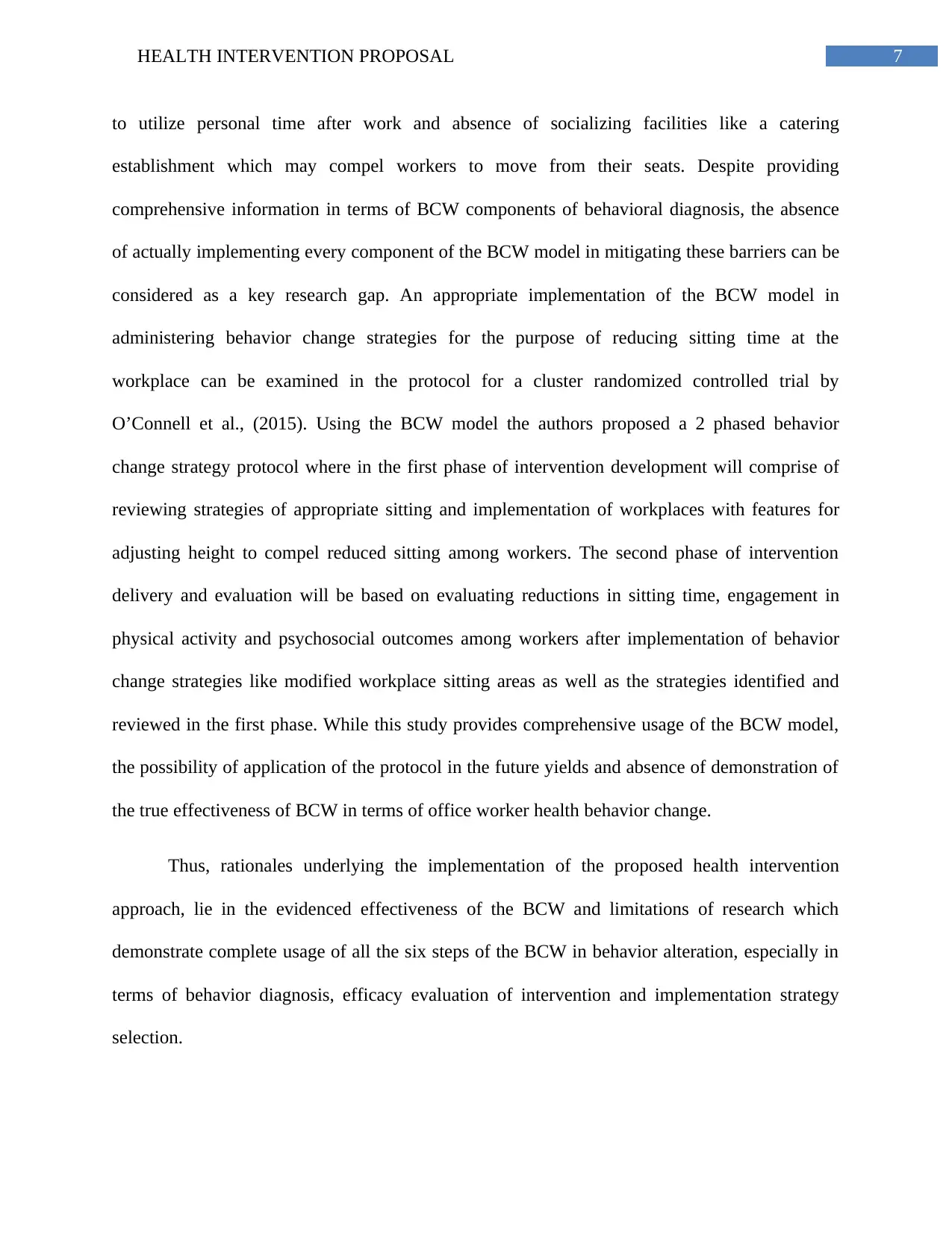
7HEALTH INTERVENTION PROPOSAL
to utilize personal time after work and absence of socializing facilities like a catering
establishment which may compel workers to move from their seats. Despite providing
comprehensive information in terms of BCW components of behavioral diagnosis, the absence
of actually implementing every component of the BCW model in mitigating these barriers can be
considered as a key research gap. An appropriate implementation of the BCW model in
administering behavior change strategies for the purpose of reducing sitting time at the
workplace can be examined in the protocol for a cluster randomized controlled trial by
O’Connell et al., (2015). Using the BCW model the authors proposed a 2 phased behavior
change strategy protocol where in the first phase of intervention development will comprise of
reviewing strategies of appropriate sitting and implementation of workplaces with features for
adjusting height to compel reduced sitting among workers. The second phase of intervention
delivery and evaluation will be based on evaluating reductions in sitting time, engagement in
physical activity and psychosocial outcomes among workers after implementation of behavior
change strategies like modified workplace sitting areas as well as the strategies identified and
reviewed in the first phase. While this study provides comprehensive usage of the BCW model,
the possibility of application of the protocol in the future yields and absence of demonstration of
the true effectiveness of BCW in terms of office worker health behavior change.
Thus, rationales underlying the implementation of the proposed health intervention
approach, lie in the evidenced effectiveness of the BCW and limitations of research which
demonstrate complete usage of all the six steps of the BCW in behavior alteration, especially in
terms of behavior diagnosis, efficacy evaluation of intervention and implementation strategy
selection.
to utilize personal time after work and absence of socializing facilities like a catering
establishment which may compel workers to move from their seats. Despite providing
comprehensive information in terms of BCW components of behavioral diagnosis, the absence
of actually implementing every component of the BCW model in mitigating these barriers can be
considered as a key research gap. An appropriate implementation of the BCW model in
administering behavior change strategies for the purpose of reducing sitting time at the
workplace can be examined in the protocol for a cluster randomized controlled trial by
O’Connell et al., (2015). Using the BCW model the authors proposed a 2 phased behavior
change strategy protocol where in the first phase of intervention development will comprise of
reviewing strategies of appropriate sitting and implementation of workplaces with features for
adjusting height to compel reduced sitting among workers. The second phase of intervention
delivery and evaluation will be based on evaluating reductions in sitting time, engagement in
physical activity and psychosocial outcomes among workers after implementation of behavior
change strategies like modified workplace sitting areas as well as the strategies identified and
reviewed in the first phase. While this study provides comprehensive usage of the BCW model,
the possibility of application of the protocol in the future yields and absence of demonstration of
the true effectiveness of BCW in terms of office worker health behavior change.
Thus, rationales underlying the implementation of the proposed health intervention
approach, lie in the evidenced effectiveness of the BCW and limitations of research which
demonstrate complete usage of all the six steps of the BCW in behavior alteration, especially in
terms of behavior diagnosis, efficacy evaluation of intervention and implementation strategy
selection.
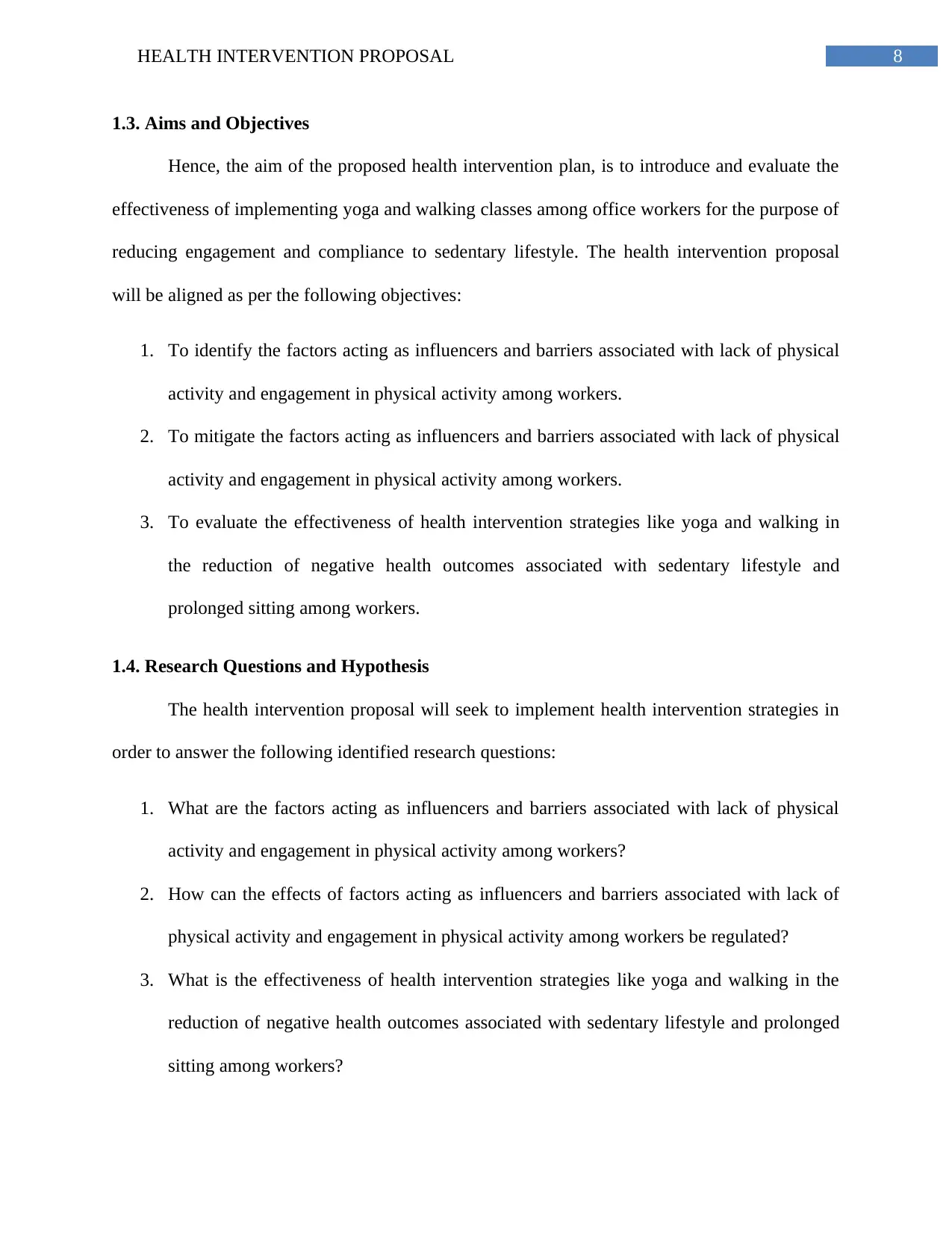
8HEALTH INTERVENTION PROPOSAL
1.3. Aims and Objectives
Hence, the aim of the proposed health intervention plan, is to introduce and evaluate the
effectiveness of implementing yoga and walking classes among office workers for the purpose of
reducing engagement and compliance to sedentary lifestyle. The health intervention proposal
will be aligned as per the following objectives:
1. To identify the factors acting as influencers and barriers associated with lack of physical
activity and engagement in physical activity among workers.
2. To mitigate the factors acting as influencers and barriers associated with lack of physical
activity and engagement in physical activity among workers.
3. To evaluate the effectiveness of health intervention strategies like yoga and walking in
the reduction of negative health outcomes associated with sedentary lifestyle and
prolonged sitting among workers.
1.4. Research Questions and Hypothesis
The health intervention proposal will seek to implement health intervention strategies in
order to answer the following identified research questions:
1. What are the factors acting as influencers and barriers associated with lack of physical
activity and engagement in physical activity among workers?
2. How can the effects of factors acting as influencers and barriers associated with lack of
physical activity and engagement in physical activity among workers be regulated?
3. What is the effectiveness of health intervention strategies like yoga and walking in the
reduction of negative health outcomes associated with sedentary lifestyle and prolonged
sitting among workers?
1.3. Aims and Objectives
Hence, the aim of the proposed health intervention plan, is to introduce and evaluate the
effectiveness of implementing yoga and walking classes among office workers for the purpose of
reducing engagement and compliance to sedentary lifestyle. The health intervention proposal
will be aligned as per the following objectives:
1. To identify the factors acting as influencers and barriers associated with lack of physical
activity and engagement in physical activity among workers.
2. To mitigate the factors acting as influencers and barriers associated with lack of physical
activity and engagement in physical activity among workers.
3. To evaluate the effectiveness of health intervention strategies like yoga and walking in
the reduction of negative health outcomes associated with sedentary lifestyle and
prolonged sitting among workers.
1.4. Research Questions and Hypothesis
The health intervention proposal will seek to implement health intervention strategies in
order to answer the following identified research questions:
1. What are the factors acting as influencers and barriers associated with lack of physical
activity and engagement in physical activity among workers?
2. How can the effects of factors acting as influencers and barriers associated with lack of
physical activity and engagement in physical activity among workers be regulated?
3. What is the effectiveness of health intervention strategies like yoga and walking in the
reduction of negative health outcomes associated with sedentary lifestyle and prolonged
sitting among workers?
⊘ This is a preview!⊘
Do you want full access?
Subscribe today to unlock all pages.

Trusted by 1+ million students worldwide
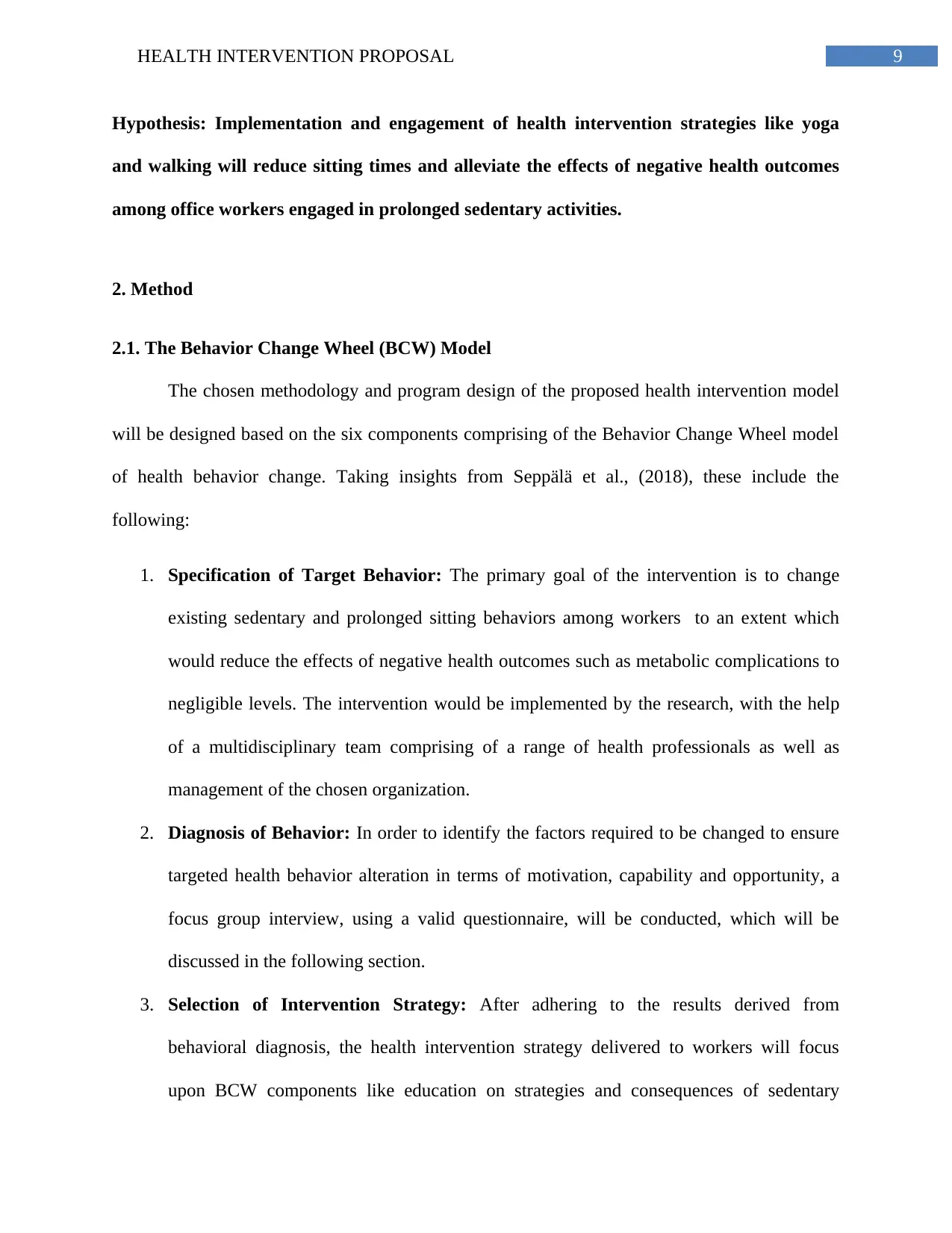
9HEALTH INTERVENTION PROPOSAL
Hypothesis: Implementation and engagement of health intervention strategies like yoga
and walking will reduce sitting times and alleviate the effects of negative health outcomes
among office workers engaged in prolonged sedentary activities.
2. Method
2.1. The Behavior Change Wheel (BCW) Model
The chosen methodology and program design of the proposed health intervention model
will be designed based on the six components comprising of the Behavior Change Wheel model
of health behavior change. Taking insights from Seppälä et al., (2018), these include the
following:
1. Specification of Target Behavior: The primary goal of the intervention is to change
existing sedentary and prolonged sitting behaviors among workers to an extent which
would reduce the effects of negative health outcomes such as metabolic complications to
negligible levels. The intervention would be implemented by the research, with the help
of a multidisciplinary team comprising of a range of health professionals as well as
management of the chosen organization.
2. Diagnosis of Behavior: In order to identify the factors required to be changed to ensure
targeted health behavior alteration in terms of motivation, capability and opportunity, a
focus group interview, using a valid questionnaire, will be conducted, which will be
discussed in the following section.
3. Selection of Intervention Strategy: After adhering to the results derived from
behavioral diagnosis, the health intervention strategy delivered to workers will focus
upon BCW components like education on strategies and consequences of sedentary
Hypothesis: Implementation and engagement of health intervention strategies like yoga
and walking will reduce sitting times and alleviate the effects of negative health outcomes
among office workers engaged in prolonged sedentary activities.
2. Method
2.1. The Behavior Change Wheel (BCW) Model
The chosen methodology and program design of the proposed health intervention model
will be designed based on the six components comprising of the Behavior Change Wheel model
of health behavior change. Taking insights from Seppälä et al., (2018), these include the
following:
1. Specification of Target Behavior: The primary goal of the intervention is to change
existing sedentary and prolonged sitting behaviors among workers to an extent which
would reduce the effects of negative health outcomes such as metabolic complications to
negligible levels. The intervention would be implemented by the research, with the help
of a multidisciplinary team comprising of a range of health professionals as well as
management of the chosen organization.
2. Diagnosis of Behavior: In order to identify the factors required to be changed to ensure
targeted health behavior alteration in terms of motivation, capability and opportunity, a
focus group interview, using a valid questionnaire, will be conducted, which will be
discussed in the following section.
3. Selection of Intervention Strategy: After adhering to the results derived from
behavioral diagnosis, the health intervention strategy delivered to workers will focus
upon BCW components like education on strategies and consequences of sedentary
Paraphrase This Document
Need a fresh take? Get an instant paraphrase of this document with our AI Paraphraser
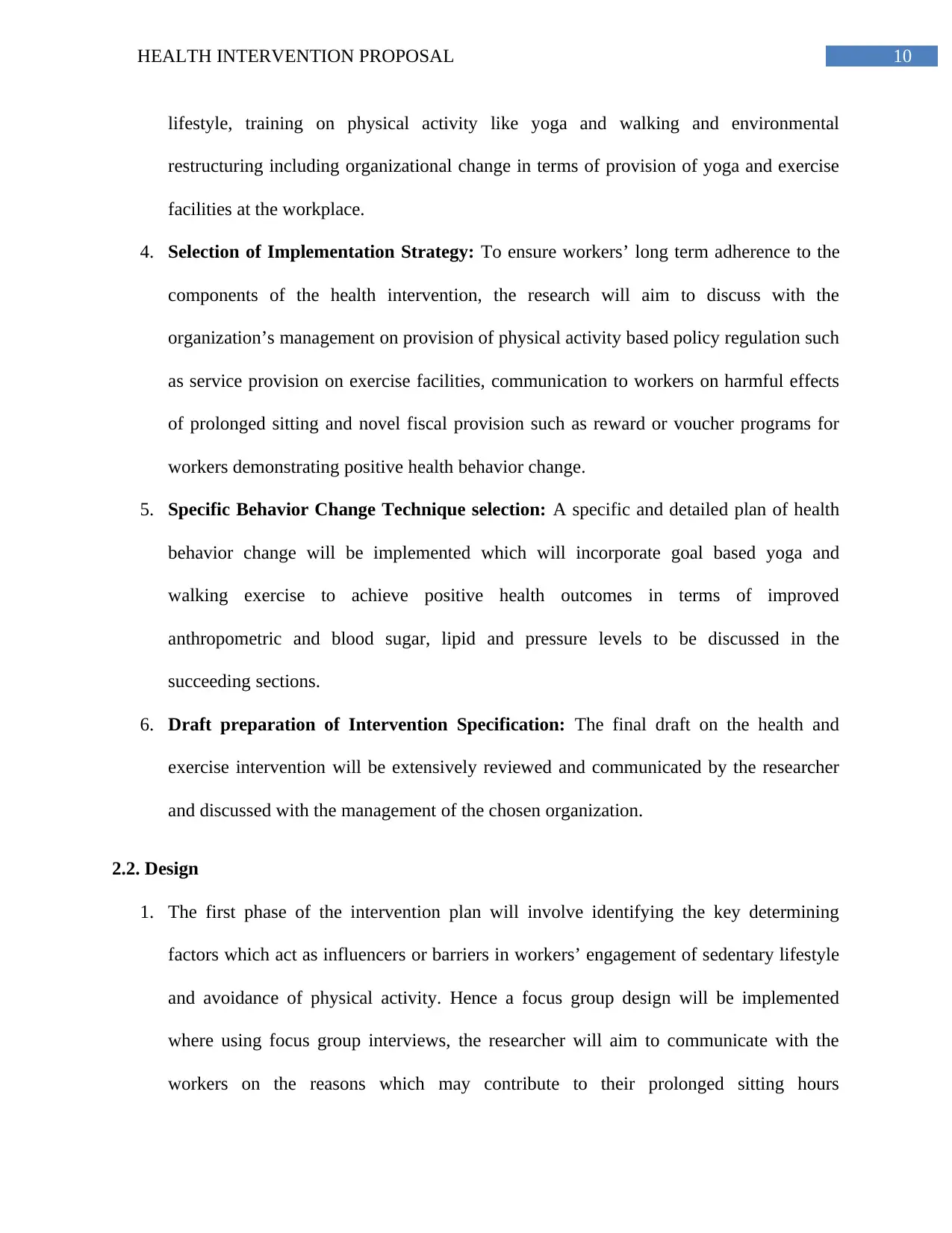
10HEALTH INTERVENTION PROPOSAL
lifestyle, training on physical activity like yoga and walking and environmental
restructuring including organizational change in terms of provision of yoga and exercise
facilities at the workplace.
4. Selection of Implementation Strategy: To ensure workers’ long term adherence to the
components of the health intervention, the research will aim to discuss with the
organization’s management on provision of physical activity based policy regulation such
as service provision on exercise facilities, communication to workers on harmful effects
of prolonged sitting and novel fiscal provision such as reward or voucher programs for
workers demonstrating positive health behavior change.
5. Specific Behavior Change Technique selection: A specific and detailed plan of health
behavior change will be implemented which will incorporate goal based yoga and
walking exercise to achieve positive health outcomes in terms of improved
anthropometric and blood sugar, lipid and pressure levels to be discussed in the
succeeding sections.
6. Draft preparation of Intervention Specification: The final draft on the health and
exercise intervention will be extensively reviewed and communicated by the researcher
and discussed with the management of the chosen organization.
2.2. Design
1. The first phase of the intervention plan will involve identifying the key determining
factors which act as influencers or barriers in workers’ engagement of sedentary lifestyle
and avoidance of physical activity. Hence a focus group design will be implemented
where using focus group interviews, the researcher will aim to communicate with the
workers on the reasons which may contribute to their prolonged sitting hours
lifestyle, training on physical activity like yoga and walking and environmental
restructuring including organizational change in terms of provision of yoga and exercise
facilities at the workplace.
4. Selection of Implementation Strategy: To ensure workers’ long term adherence to the
components of the health intervention, the research will aim to discuss with the
organization’s management on provision of physical activity based policy regulation such
as service provision on exercise facilities, communication to workers on harmful effects
of prolonged sitting and novel fiscal provision such as reward or voucher programs for
workers demonstrating positive health behavior change.
5. Specific Behavior Change Technique selection: A specific and detailed plan of health
behavior change will be implemented which will incorporate goal based yoga and
walking exercise to achieve positive health outcomes in terms of improved
anthropometric and blood sugar, lipid and pressure levels to be discussed in the
succeeding sections.
6. Draft preparation of Intervention Specification: The final draft on the health and
exercise intervention will be extensively reviewed and communicated by the researcher
and discussed with the management of the chosen organization.
2.2. Design
1. The first phase of the intervention plan will involve identifying the key determining
factors which act as influencers or barriers in workers’ engagement of sedentary lifestyle
and avoidance of physical activity. Hence a focus group design will be implemented
where using focus group interviews, the researcher will aim to communicate with the
workers on the reasons which may contribute to their prolonged sitting hours
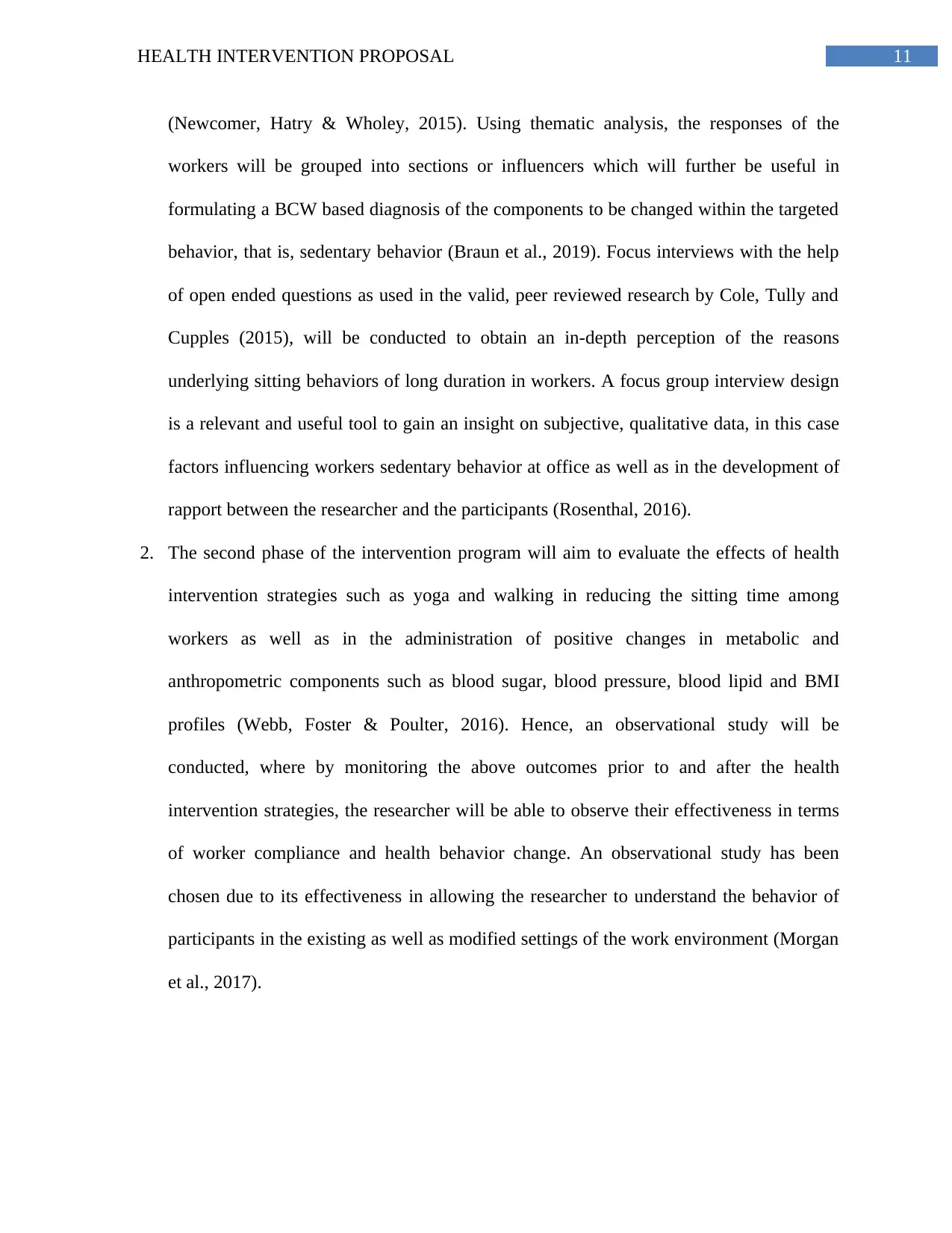
11HEALTH INTERVENTION PROPOSAL
(Newcomer, Hatry & Wholey, 2015). Using thematic analysis, the responses of the
workers will be grouped into sections or influencers which will further be useful in
formulating a BCW based diagnosis of the components to be changed within the targeted
behavior, that is, sedentary behavior (Braun et al., 2019). Focus interviews with the help
of open ended questions as used in the valid, peer reviewed research by Cole, Tully and
Cupples (2015), will be conducted to obtain an in-depth perception of the reasons
underlying sitting behaviors of long duration in workers. A focus group interview design
is a relevant and useful tool to gain an insight on subjective, qualitative data, in this case
factors influencing workers sedentary behavior at office as well as in the development of
rapport between the researcher and the participants (Rosenthal, 2016).
2. The second phase of the intervention program will aim to evaluate the effects of health
intervention strategies such as yoga and walking in reducing the sitting time among
workers as well as in the administration of positive changes in metabolic and
anthropometric components such as blood sugar, blood pressure, blood lipid and BMI
profiles (Webb, Foster & Poulter, 2016). Hence, an observational study will be
conducted, where by monitoring the above outcomes prior to and after the health
intervention strategies, the researcher will be able to observe their effectiveness in terms
of worker compliance and health behavior change. An observational study has been
chosen due to its effectiveness in allowing the researcher to understand the behavior of
participants in the existing as well as modified settings of the work environment (Morgan
et al., 2017).
(Newcomer, Hatry & Wholey, 2015). Using thematic analysis, the responses of the
workers will be grouped into sections or influencers which will further be useful in
formulating a BCW based diagnosis of the components to be changed within the targeted
behavior, that is, sedentary behavior (Braun et al., 2019). Focus interviews with the help
of open ended questions as used in the valid, peer reviewed research by Cole, Tully and
Cupples (2015), will be conducted to obtain an in-depth perception of the reasons
underlying sitting behaviors of long duration in workers. A focus group interview design
is a relevant and useful tool to gain an insight on subjective, qualitative data, in this case
factors influencing workers sedentary behavior at office as well as in the development of
rapport between the researcher and the participants (Rosenthal, 2016).
2. The second phase of the intervention program will aim to evaluate the effects of health
intervention strategies such as yoga and walking in reducing the sitting time among
workers as well as in the administration of positive changes in metabolic and
anthropometric components such as blood sugar, blood pressure, blood lipid and BMI
profiles (Webb, Foster & Poulter, 2016). Hence, an observational study will be
conducted, where by monitoring the above outcomes prior to and after the health
intervention strategies, the researcher will be able to observe their effectiveness in terms
of worker compliance and health behavior change. An observational study has been
chosen due to its effectiveness in allowing the researcher to understand the behavior of
participants in the existing as well as modified settings of the work environment (Morgan
et al., 2017).
⊘ This is a preview!⊘
Do you want full access?
Subscribe today to unlock all pages.

Trusted by 1+ million students worldwide
1 out of 24
Related Documents
Your All-in-One AI-Powered Toolkit for Academic Success.
+13062052269
info@desklib.com
Available 24*7 on WhatsApp / Email
![[object Object]](/_next/static/media/star-bottom.7253800d.svg)
Unlock your academic potential
Copyright © 2020–2025 A2Z Services. All Rights Reserved. Developed and managed by ZUCOL.



